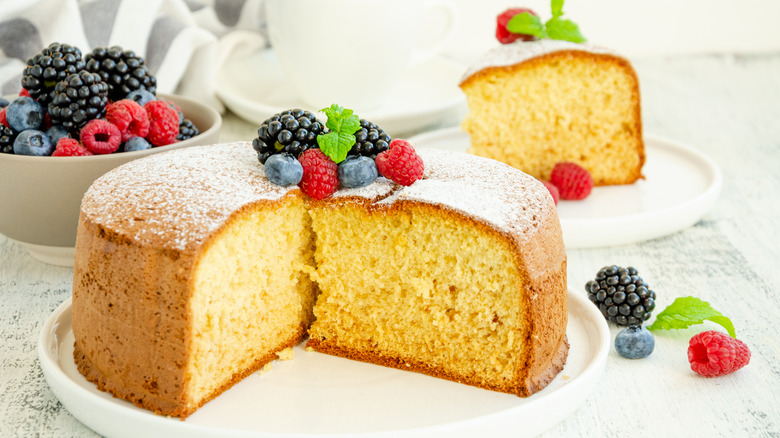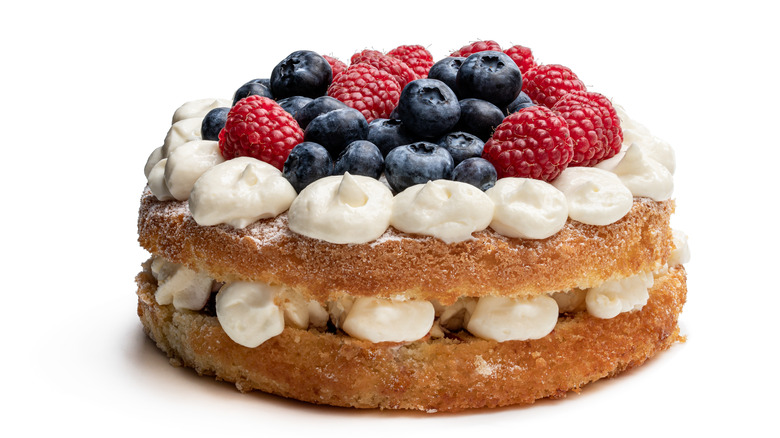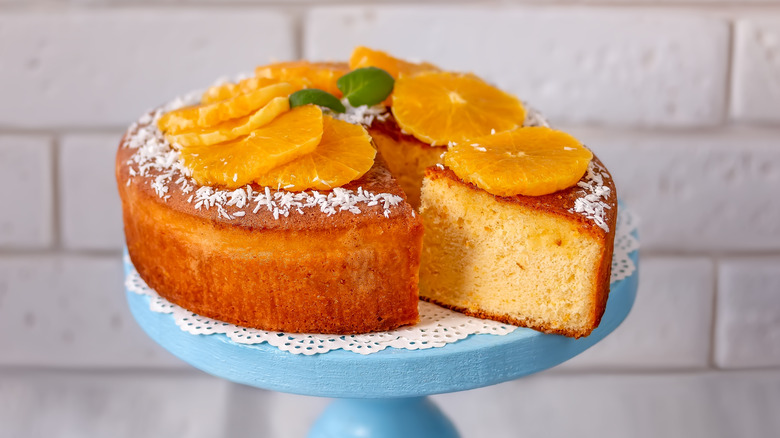What's The Difference Between Sponge Cake And Chiffon Cake?
"Let them eat cake," goes the English-language version of Marie Antoinette's almost-undoubtedly apocryphal quote. While this probable bit of propaganda played a part in ending the reign and lives of Marie and her husband, Louis XVI, it has also come to represent the decadent frivolity of cake itself.
There are countless varieties of cake found around the world, drawing on the global library of flours, sweeteners, leavening agents, and, regularly, fats and oils. In their etymological history of the word cake, Bon Appétit points to the late 14th century as the introduction of "cake" into the English language with the word's roots lying in "kaak" similar to the Icelandic "kaka" still used today. The concept of an unleavened lump of cooked dough — the original meaning of cake — stretches much further back, all the way to Egypt circa 2600 B.C. (via The Modern East.)
As with most culinary imports, once cake came to America, it was adapted to suit regional tastes and available ingredients, as outlined in NPR's profile of Anne Bryn's book "American Cake." We added to the great baking lexicon such variants as Apple Stack Cake, Moravian Sugar Cake, and the egg-less Cowboy Cake.
Two cakes familiar to modern bakers are sponge and chiffon. While similar, these two cakes diverge in ways that make them both delicious and distinct. So, just what is it that sets these two apart?
Sponge cake explained
Sponge cake is, like the mother sauces of French cuisine, a progenitor to many variations. The earliest and most quintessential sponge cake recipe was included in "The English Huswife," a 17th century book of cooking, brewing, distilling, and general housekeeping by poet Gervase Markham. It calls for flour, sugar, and eggs, whole and yolks, spiced with anise and coriander seeds all beaten to incorporate a good deal of air, which, along with the heat of baking, allows the cake to rise (via Baker's Peel).
From the humble sponge cake have sprung many children. For instance, the Franco-Italian version is known as Gateau Genoise, and, as explained by Epicurious, it involves the addition of fat in the form of butter. This can weigh down what is normally a very delicate batter, so extra egg yolks are added for structure and support.
Perhaps one of the best known versions of sponge cake, at least in the U.S., is angel food cake, which is fitting as it was invented in the states. A favorite of the calorie conscious, says Martha Stewart, angel food cake eschews fat in the form of butter and egg yolks to produce a delicate, airy crumb of whipped egg whites, sugar, and flour with the occasional addition of cream of tartar.
From sponge to chiffon
Chiffon cake is yet another derivation of sponge cake, but it marks a profound shift as it includes vegetable oil and baking soda (via Epicurious.) The eggs in a chiffon cake are separated and the whites whipped to incorporate air, giving it the characteristic fluffiness of a sponge cake. But the vegetable oil and egg yolks add a distinct richness that gives more heft and density to chiffon cake compared to sponge.
Chiffon cake, like angel food, is an American invention, and a recent one at that. Taste Atlas credits the aptly named Harry Baker, a California salesman with a penchant for baking, as the originator of the recipe, which remained his personal secret for more than 20 years. It was upon his sale of the chiffon cake recipe to the company that would become General Mills in 1948 that it became a staple of modern cookery.
Ungreased tube pans are often employed in the baking of chiffon cakes — as well as angel food — for added lift, notes Better Homes & Gardens. With a greater surface area than a round or square pan, the tube allows the chiffon cake to stick to the walls and climb higher.
If you're looking to get into the cake-making game and don't know where to start, take a tip from the folks at Southern Living. While they offer recipes for both sponge and chiffon cakes, they advise trying chiffon first as it provides a little more room for error.


